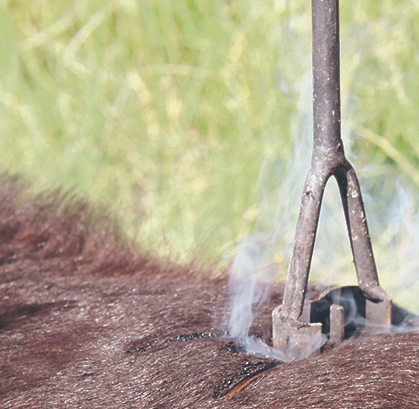Animals can be marked for identification using either hot branding or freeze branding techniques. The branding process is similar for both, but there are some key distinctions.
A branding iron is cooled with liquid nitrogen during the process of freeze branding, which is also referred to as cryo-branding. After applying pressure to the animal's skin with the branding iron, the hair follicles freeze and rupture, leaving a distinctive and permanent white mark. This procedure is frequently employed on horses and other sensitive-skinned livestock since it is less irritating than heat branding.
However, hot branding requires using a branding iron heated to extremely high temperatures, which is then pressed onto the skin of the animal, resulting in a burn and a permanent scar. Due to the scar's visibility, this procedure is frequently applied to cattle and other animals with thicker skin because it is seen to be a more accurate means of identification.

Freeze branding vs Hot branding
Freeze branding is a relatively harmless and highly effective method for permanently identifying animals and herds. The aim of freeze branding is to convert hair color to white in a legible manner, as opposed to hot iron branding, which creates a tidy, apparent scar on the surface of the hide. The natural colors in the hair are destroyed by freeze branding, which results in the growth of white hair.
Fire branding, or hot branding, has been used for a long time to identify animals. There will be permanent hair loss in that location as a result of burning a brand into the hair follicles. There are two varieties of irons that can be employed, namely steel irons and electric irons. While steel irons must be hot enough but not to the point of burning, electric irons maintain a constant temperature. The color of the iron is a good indicator; a wood-ash grey is ideal. Freeze branding involves lowering the temperature of the branding iron from -78C to -196C. The animal is held still while a small patch of fur is shaven where the brand will be placed. The hair turns permanently white after freeze branding, which destroys the color follicles in the hair. When used on white animals, the iron is left in place long enough to permanently damage the hair follicle and prevent regrowth.
Both hot branding and freeze branding are legal techniques for identifying livestock; however, the specific restrictions that apply in a given area may differ from those that apply in other areas. Freeze branding is not recognized as a valid way of identification in several geographic locations. Freeze branding, on the other hand, is generally seen to be more moral than hot branding, which entails using a heated iron stamp to sear a permanent mark into the skin of the animal. As compared to hot branding, it is believed that freeze branding causes less discomfort and damage. Hot branding is still frequently employed, however many producers no longer use branding at all and instead rely on ear tags and tattoos for identification.
Unlike many hot-iron brands or ear tags, freeze branding can leave permanent, highly visible marks that can be read from a long distance. In order to make the brand more noticeable, freeze branding destroys the color follicles in the hair, turning it permanently white. It is simple to recognize the chosen animal because of the white hair follicles against the colored background. Hot branding, on the other hand, involves burning a mark into the hair follicles.







0 Comments
For comments please reply here.......